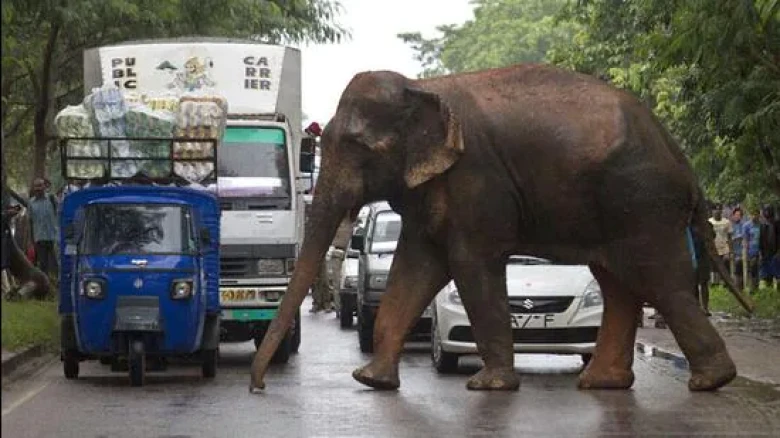Regional

The two tuskers' poaching is one of 13 instances of elephants dying unexpectedly in Odisha forests over the course of the past two months, making it the largest short-term loss of life for pachyderms in more than a decade.
color:black;mso-themecolor:text1">
color:black;mso-themecolor:text1">Digital Desk: On July 29, a 25-year-old
tusker with at least five pellet wounds to its head and ear in the Narasinghpur
East range of the Athagarh forest division of Cuttack district passed away from
organ failure. One of the pellets may have pierced deeply into the tusker's
head, according to the veterinarians who attempted to treat it but were
unsuccessful. The injured elephant was originally spotted by locals in the
Athagarh division on July 23, who then alerted wildlife activists and the chief
wildlife warden. The elephant is most likely the victim of a group of neighbourhood
poachers.
mso-themecolor:text1">On July 25, it was tranquillized, but it was too late
because the pellet wounds had already set out septicemia.
mso-themecolor:text1">
The tusker's death was a repetition of a
similar poaching incident that occurred in June's first week, when locals
discovered a different tusker writhing in agony in the same woodland area with
at least five pellet wounds to its trunk, face, legs, and body. After former
BJD minister and local MLA Debi Prasad Mishra brought the elephant's plight to
the attention of state forest minister Pradip Amat in his Facebook post, a team
of veterinarians from Nandankanan Zoo in Bhubaneswar was dispatched to cure the
animal. A week later the elephant passed away.
The two tuskers' poaching is one of 13
instances of elephants dying unexpectedly in Odisha forests over the course of
the past two months, making it the largest short-term loss of life for
pachyderms in more than a decade. Of the 13, at least 5 are the result of
poaching, including the death of a 40-year-old tusker, whose decomposing body
and gunshot wound were discovered late last month in a cashew plantation in the
Jagannath Prasad forest area in the Ghumsur North Division of the Ganjam
district.
Two persons were detained on Saturday after
forest department officers removed an elephant's tusk from a toilet pipe in the
area. The Odisha police's special task unit discovered the bones and carcasses
of five elephants, including a tusker, in the Athagarh forest area in June and
July. One of the elephants had allegedly been shot dead and buried by forest
department employees in order to hide their deaths.
An independent investigative committee of the
National Tiger Conservation Authority discovered the remains of 14 elephants in
the Similipal Tiger Reserve of the Mayurbhanj district in April and May 2010,
causing a significant commotion in the woods of Odisha. The investigation team
discovered that the corpses had been burned and destroyed by the field crew in
order to obliterate evidence.
While the state forest department acted
quickly in the Similipal poaching case, suspending numerous officials, 10
forest department employees, including a forester, have been arrested in the
Athagarh division case this year, while two rangers have been booked on
accusations of information suppression. In order to look into the escalating
number of elephant deaths and claims of cover-ups, the government has also
assembled a special investigation team made up of forest and CID officers,
although poaching seems to be unabated.
Local wildlife advocates claim that poachers
are out of control since the forest service has failed to crack down on
wildlife crimes or secure even a single conviction over the past two decades.
Elephants are protected under Schedule I of
the Wildlife (Protection) Act, 1972, and murdering one carries a seven-year
prison sentence; yet, no poachers or ivory traders have been found guilty in
the past 20 years. The Orissa High Court had stated in 2015 that the widespread
poaching for the ivory trade is producing an alarming scenario while refusing
bail to infamous poacher Afzal Baig who had been accused in 5 incidents of
elephant poaching. "Despite the fact that the elephant population in
Odisha increased from 1930 in 2012 to 1954 in 2015, according to the 2015
Elephant Census Report, poaching is creating a worrying situation. Such
behaviour is nothing less than a heinous and violent crime, the HC declared.
According to government figures, 426 of the
at least 970 elephant deaths in Odisha since 2010 were caused by natural
causes. Due to the bodies' extreme decomposition, the cause of death was
unknown in more than 200 cases. According to Mohanty, 144 elephants were electrocuted
while at least 133 were either poisoned or poached.
Although the Odisha government released a
circular in 2012 holding DFOs responsible for each and every unintentional
death of an elephant, activists claimed that the circular has only ever existed
on paper.
Belinda Wright, a well-known conservationist,
claimed that there is a greater wildlife disaster than the government is
willing to acknowledge due to the increased number of elephant deaths from
poaching and the concealment of carcasses. If they keep the incident quiet, the
Odisha Forest Department won't be able to look into these horrifying alleged
crimes against some of their coworkers. The investigation should be open and
include reputable, independent specialists from outside the department, she
added, for the sake of Odisha and the department itself.
The state is experiencing its highest level
of human-elephant conflict at the same time when elephant deaths are on the
rise. Bhupender Yadav, the Union Minister for Environment, Forestry, and
Climate Change, said to the Lok Sabha last month that the majority of the 1,578
individuals killed in elephant attacks in India between 2019–20 and 2021–22, 322
fatalities came from Odisha. West Bengal came in second with 240 cases,
followed by Jharkhand with 291 cases.
Leave A Comment